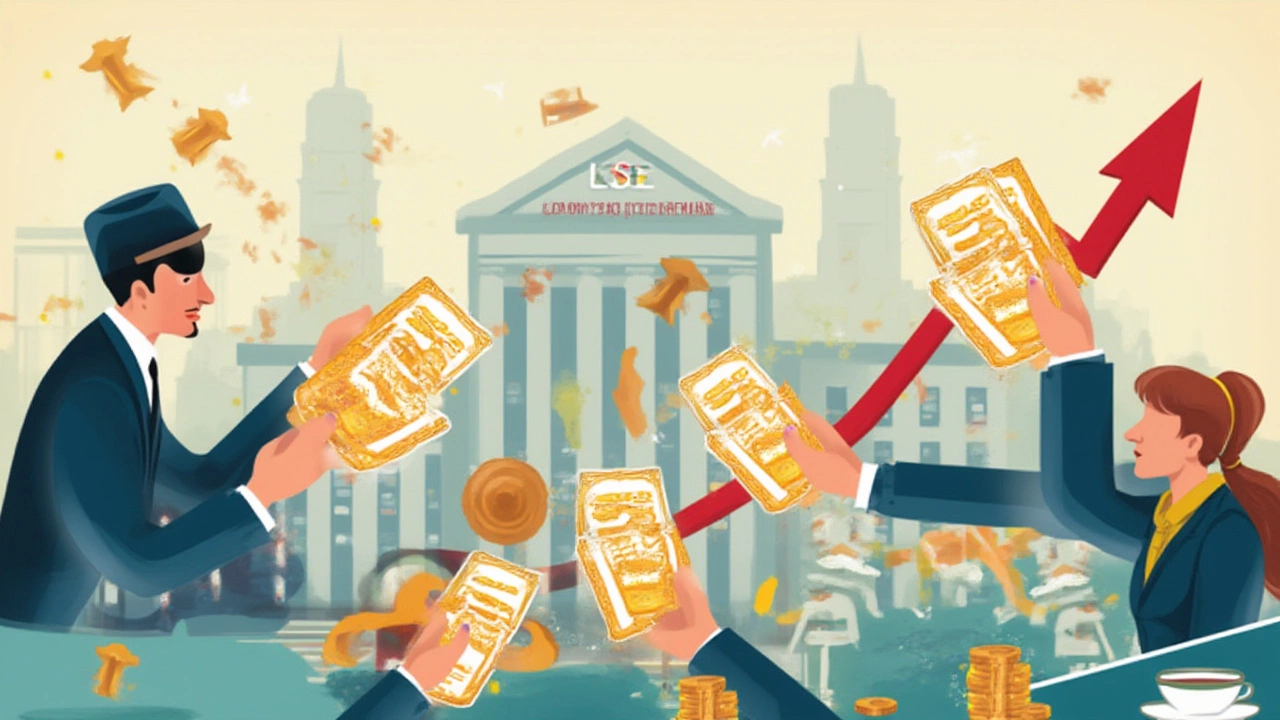Imagine waking up to a fat deposit in your account just for holding the right stock. Some people actually enjoy thousands in extra cash—without lifting a finger on the job. Dividend investing’s got a serious fanbase for one gorgeous reason: regular payouts for shareholders, usually every three months. But not all stocks are created equal; some cough up pocket change, others make it rain. Chasing the best dividend stock? Buckle up, because there’s more to this game than just picking the highest yield from a screener. We’re digging into the facts, exploring numbers that matter in 2025, and looking at clever ways to grow your own passive money tree.
What Actually Makes a Stock the "Best Dividend"?
Let’s clear up a myth right away: The "best dividend stock" isn’t necessarily the one flashing the highest yield. If it looks too good to be true, it often is. Some stocks throw out high dividends only to slash them when profits drop—a big, ugly surprise for investors banking on steady cash. The sweet spot? Consistency, reliability, and steady growth. Growing dividends, year after year, say a lot about a company’s health and mindset. Think about it like this: would you rather get 14% from a struggling oil company that might tank next quarter, or 3% from a mega-cap that’s paid investors for 50 years running and keeps nudging its payout higher?
Take Johnson & Johnson as an example. This company has boosted its dividend for more than 60 years straight—even through recessions and crises. Sure, its current yield floats around 3%, which isn’t headline-grabbing, but the payment is rock solid. Compare that to a shaky regional bank flashing 8% today and known for slicing dividends when the market turns south. Choosing between these is less about gaming the number and more about betting on the business staying power.
Other signs that set a great dividend stock apart? Low payout ratio (meaning they don't pay out all profits as dividends), healthy profit margins, and room for long-term growth. Companies in sectors like consumer staples, healthcare, energy, and utilities have earned their reputations as dividend workhorses. Coca-Cola, for instance, has not only paid dividends for over a century, but it’s also hiked that payout for 62 consecutive years. This is serious stamina and a sign of real financial health. Check a stock’s history before you jump in—the past often repeats in dividends, too.
Dividend aristocrats—a term coined for companies in the S&P 500 that have increased their dividend for at least 25 consecutive years—are usually among the top picks. Examples include Procter & Gamble, Colgate-Palmolive, and PepsiCo. For folks chasing peace of mind over roller-coaster returns, these names have become the backbone of many retirement portfolios.
Don't forget tax efficiency, either. In the U.S., qualified dividends often get taxed at a lower rate than regular income, which can nudge your real returns higher. And in 2025, there's rising interest in using retirement accounts (like IRAs) to shelter that growing dividend stream from Uncle Sam.
At the end of the day, “What stock pays the best dividend?” really depends on your goals: Do you want consistent deposits or are you okay with risk for juicier, but shakier, checks? Knowing your own style helps more than following a popular ticker.
Big Payers in 2025: Who’s Delivering the Highest Dividends?
If you want big payouts right now, you’ll probably wander into energy, utilities, or real estate stocks. Pipeline kingpins like Enbridge (ENB) and Kinder Morgan (KMI) have been dishing out eye-popping dividends. Enbridge, in 2025, is sitting at a yield pushing 7.5%. Kinder Morgan isn’t far behind. What’s interesting? These companies make most of their money from moving oil and gas through owned pipes and storage—not the commodities themselves. This means they often stay in the green, even if oil prices swing. If stability matters, midstream energy companies have become a sweet spot for income hunters.
Outside of energy, real estate investment trusts (REITs) have become favorites for those chasing income. Realty Income (O), with its “monthly dividend company” nickname, pays cash every 30 days and has notched up more than 630 monthly payments in a row. For 2025, its yield is just under 5%, which may not sound super high, but that consistency is tough to beat. The REIT space is huge—from data center specialists like Digital Realty Trust to apartment kings like AvalonBay—covering almost any niche you can dream up.
Big telecoms have also staked out a spot in the income space. AT&T, as of now, sits around a 6.7% yield—though it’s worth remembering that management slashed the payment a few years back, and that memory hasn’t faded for a lot of long-time investors. Verizon, on the other hand, has made it through recent rough waters and still pays north of 7%. These payouts can look irresistible, but both companies face debt mountains and stiff competition, so due diligence isn’t optional.
If you go global, the picture changes a bit. British American Tobacco offers yields over 8%, though it also comes bundled with regulatory and market risks. Australia’s big banks, like Westpac, and leading European utility firms, like Enel, are kicking out impressive yields. Taxes and currency swings can nibble away at these, but for those with a global focus, they’re worth a look.
For the risk-tolerant, business development companies (BDCs) like Main Street Capital (MAIN) or Ares Capital (ARCC) sometimes hit the double digits for yield. Keep in mind, though: BDCs typically serve as lenders to smaller, sometimes struggling businesses, giving them exposure to bumps when the economy slows down. These stocks are like hot sauce—great in small doses, not for the faint-hearted.
And let’s not forget master limited partnerships (MLPs), such as Enterprise Products Partners (EPD), yielding around 7.9% this year. MLPs toss out regular cash but come with their own tax quirks, so always check how those payments are treated come filing season.
Bottom line? Do your homework. Pay attention not just to the sizzling number, but to whether that payout is built on stable cash flows and a solid balance sheet. High yield can be a mirage if the business is shrinking or bleeding red ink.

How to Pick a Great Dividend Stock in Today’s Market
So, now that you know where the fattest checks are coming from in 2025, how do you stack the odds in your favor when shopping for new additions? First, get a handle on the payout ratio. This metric shows how much of the company’s profit goes out to shareholders. A ratio over 80% often signals trouble—if business drops, there’s little wiggle room. Experts love payout ratios between 40% and 60% for most industries; that’s enough for income, but not so much the company can’t reinvest in itself.
Next, check the company’s debt. If you see rising interest expenses with flat or falling sales, watch out. Even a high yield can turn sour if debt chokes the company’s options. Look for dividend growth. Has the payout increased consistently? Companies that managed to raise dividends through rough times—like the 2020 pandemic or the 2008 crisis—deserve major trust points.
Evaluate industry trends. Are people still buying what the business sells? Consumer staples, like food and cleaning products, tend to do well no matter what’s happening in the market. Energy and utilities often bounce back fast from downturns. Tech stocks, on the other hand, rarely pay big dividends, preferring to plow cash back into growth. But a few tech giants—like Microsoft and Apple—have started paying regular, growing dividends, making them unusual but attractive picks for balanced investors.
Don’t overlook management’s reputation, either. Companies led by reliable, transparent teams tend to avoid dividend cuts and nasty surprises. Bonus points if executives also own a chunk of company stock themselves—it means their priorities likely line up with yours.
One more tip: Spread your bets. Don’t pour your cash into a single dividend darling. Building a portfolio of five to ten solid dividend payers can smooth out the bumps. When oil slumps, maybe your healthcare or consumer goods pick keeps delivering. If real estate hits a rough patch, energy or telecom might fill the gap.
Finally, revisit your holdings at least once a year. Times change. A stock that looked perfect two years ago might be losing ground, or another company could be on the rise. Swapping out underperformers and reinvesting those dividends can pump up your returns over time.
For the hands-off crowd, consider dividend-focused ETFs. Funds like Vanguard Dividend Appreciation (VIG) and Schwab U.S. Dividend Equity (SCHD) do the picking for you, holding baskets of reliable dividend payers. These funds offer instant diversification and let you capture those payouts without sweating over every quarterly report.
Common Pitfalls: When Chasing Yield Goes Wrong
High-yield stocks are catnip for investors—but there’s a catch. Sometimes that big number signals trouble. Companies in distress will crank up dividends as bait to keep investors around, only to slash them down the road. It’s called a ‘dividend trap,’ and it’s burned more than a few eager hands. If the stock’s price drops sharply, that yield rises by default even if the payout hasn’t budged—a big red flag.
Another mistake: Focusing only on U.S. companies. Every year, some of the best returns come from global giants living outside New York and Chicago. Sure, there are more hurdles—currency shifts, different tax rules, and sometimes volatility—but blue-chip companies in Europe, Asia, and Canada often pay out fatter or more reliable dividends than their American counterparts. Diversifying globally gives you options and smooths out the ride.
Don’t ignore taxes. High-yield stocks in a taxable brokerage account can leave you with less cash than expected after the IRS takes its share. Some folks keep high-dividend stocks inside retirement accounts to push off or even avoid taxes. That way, more of your money actually goes to work for you, compounding year after year.
Beware of ‘serial cutters’—companies that have repeatedly dropped their dividend. The pattern usually continues. Always review a company’s recent dividend history. If you see repeated cuts over five years, think hard about why you own it.
People love to time the market—waiting for the perfect entry or jumping in when a stock temporarily spikes its dividend. This often backfires. Trying to catch that magic moment usually leads to missed opportunities or getting stuck with a problematic company. Stick to research and long-term thinking rather than quick fixes.
One final snag: Ignoring inflation’s bite. A company with a flat payout might look good today but could shrink in real buying power each year. That’s why growing dividends are a must. When prices rise, your dividend check should rise right along with it. Look for companies with ten- or twenty-year streaks of raising their payments, not just keeping them unchanged.
The best dividend stock isn’t just about yield. It's about a company’s story, a proven history, and a balance of steady checks and long-haul growth. If you’re ready to see dividends show up without unwelcome surprises, focus on reliable growers and keep risk spread across the board. That’s how you build a portfolio that keeps you smiling—even when the market’s throwing a tantrum.

